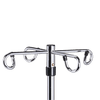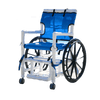Essential Advice for Aspiring Entrepreneurs in the Medical Equipment Manufacturing Industry

By Lydia Chan
Launching a business in the medical equipment manufacturing field demands more than innovation—it requires navigating regulations, ensuring quality, and building trust with healthcare providers. Whether you’re prototyping surgical instruments or designing patient-monitoring systems, success hinges on precision, compliance, and strategy.
Major Takeaways
Medical equipment manufacturing is a capital- and compliance-intensive industry. Success depends on strong quality systems, a clear regulatory strategy, strategic supplier partnerships, and early integration of scalable production processes. Use ready-made parts to reduce risk and optimize resources. Prioritize machine vision for quality assurance, and focus on documentation from day one.
The Entrepreneur’s Foundation Checklist
|
Stage |
Key Focus |
Practical Action |
|
1. Concept |
Identify unmet medical needs |
Interview clinicians; validate with patient outcomes data |
|
2. Compliance |
Understand regulatory classes |
Study FDA/CE marking requirements early |
|
3. Design |
Prototype with scalable materials |
Use CAD models and 3D printing for iteration |
|
4. Production |
Choose reliable component suppliers |
Audit vendors for ISO 13485 alignment |
|
5. QA & Safety |
Build traceable documentation |
Integrate digital tracking and test reports |
|
6. Growth |
Scale sustainably |
Optimize supply chain and inventory control |
Core Advice for New Founders
1. Start with the Problem, Not the Product
Many startups overinvest in technology before validating a market need. Begin with clinical interviews and outcome-based evidence. Align your solution with healthcare provider workflows—this is where traction starts.
2. Understand Regulatory Pathways Early
The regulatory environment defines your roadmap, so learn the process before you build. Reviewing the FDA’s information on regulation is an excellent start.
3. Design for Quality from the Start
Good design minimizes future recalls. Integrate risk management principles from ISO 14971 and ensure material traceability from early prototypes to production. You can reference the International Organization for Standardization guidelines for detailed standards.
4. Supplier and Component Strategy
Suppliers are part of your compliance ecosystem. Work with audited vendors and verify that every part meets certification requirements. Platforms such as ThomasNet can help identify trusted medical suppliers.
Integrating Reliable Components to Minimize Risk
Cost control and quality assurance are critical for medical startups. Integrating ready made parts into your assembly process can dramatically reduce lead times and limit exposure to manufacturing errors. Standardized parts from certified sources not only enhance consistency but also simplify regulatory submissions and inventory management.
Entrepreneurs who balance custom innovation with pre-qualified components gain faster approval cycles and lower operational risk.
How-To: Build a Compliant, Scalable Manufacturing Process
-
Establish Quality Systems Early
-
Implement ISO 13485-aligned documentation.
-
Use digital quality management tools like Greenlight Guru or MasterControl.
-
Validate Your Supply Chain
-
Create a vendor approval list.
-
Ensure all suppliers maintain device history records.
-
Plan for Scalability
-
Design production layouts that allow for incremental capacity.
-
Incorporate lean manufacturing practices to manage costs efficiently.
-
Invest in Post-Market Surveillance
-
Use feedback loops from hospitals and distributors.
-
Analyze complaint data to refine future product lines.
Technology and Automation in Quality Control
Modern medical manufacturing increasingly relies on automation to maintain consistency. Incorporating advanced inspection systems amplifies precision and reduces human error.
One major breakthrough lies in leveraging the impact of machine vision warehousing for real-time quality inspection. Machine vision systems detect micro-defects invisible to human inspectors and ensure components meet exact tolerance standards. Success here depends on ruggedized, high-performance computing hardware capable of operating under demanding production conditions.
Common Mistakes to Avoid
-
Skipping documentation. Every test, calibration, and change must be traceable.
-
Underestimating certification timelines. Regulatory approvals can take months—build this into financial planning.
-
Over-customizing early. Use standard parts until market demand justifies full customization.
-
Neglecting feedback. Early clinician feedback prevents costly rework later.
FAQ
Q1: How much capital is needed to start a medical device manufacturing firm?
Expect at least $500,000–$2 million in startup capital, depending on device complexity and regulatory classification.
Q2: Do I need FDA approval before manufacturing?
For Class I devices, you may only need registration. For Class II or III devices, you must submit 510(k) or PMA applications before market entry.
Q3: What’s the difference between design validation and verification?
Verification ensures the product meets specifications; validation ensures it meets user needs.
Q4: Can small companies compete with large players?
Yes—by specializing in niche innovations and maintaining agility in regulatory and supply processes.
Glossary
-
ISO 13485: International standard for medical device quality systems.
-
510(k): FDA premarket submission for proving device equivalence.
-
CE Marking: European certification allowing medical device sale.
-
QMS: Quality Management System ensuring compliance and traceability.
-
Machine Vision: Automated inspection technology using cameras and AI to verify quality.
Featured Tool Spotlight
For startups managing multiple compliance documents and supplier audits, MasterControl’s QMS platform offers automated workflows and audit trails. It’s an excellent reference model for structuring document control even before scaling.
Entrepreneurship in medical equipment manufacturing is both high-stakes and high-impact. Success requires mastering the intersection of regulation, quality, and precision. Build your venture on structured systems—not shortcuts. Leverage ready-made parts, adopt machine vision, and embrace quality as a profit center, not a cost. Your products may one day save lives—ensure they’re built with that standard from the start.
- Dansons Medical Support


 Lifts
Lifts
 Patient Lifts
Patient Lifts
 Stand Assists
Stand Assists
 Standing Aids
Standing Aids
 Slings
Slings
 Parts & Accessories
Parts & Accessories
 Wheelchairs
Wheelchairs
 Ergonomic
Ergonomic
 Portable
Portable
 Reclining
Reclining
 Standing
Standing
 Sporting
Sporting
 Bariatric
Bariatric
 Ramps
Ramps
 Modular
Modular
 Portable
Portable
 Parts & Accessories
Parts & Accessories
 Walking Aids
Walking Aids
 Rollator Walkers
Rollator Walkers
 Canes
Canes
 Crutches
Crutches
 Parts & Accessories
Parts & Accessories
 Scooters
Scooters
 4-Wheel
4-Wheel
 Folding
Folding
 Parts & Accessories
Parts & Accessories
 Nursing
Nursing
 Pregnancy Comfort
Pregnancy Comfort
 Self-Care
Self-Care
 Pump Parts
Pump Parts
 Exercise Equipment
Exercise Equipment
 Treadmills
Treadmills
 Walking Pads
Walking Pads
 Rowing Machines
Rowing Machines
 Strength & Conditioning
Strength & Conditioning
 Massage Chairs
Massage Chairs
 Saunas
Saunas
 Hot & Cold Tubs
Hot & Cold Tubs
 Stethoscopes
Stethoscopes
 Surgical Instruments
Surgical Instruments
 Forceps
Forceps
 Scalpels
Scalpels
 IV Poles
IV Poles
 Oxygen
Oxygen
 Beds
Beds
 Electric Beds
Electric Beds
 Standing Beds
Standing Beds
 Mattresses
Mattresses
 Bed Accessories
Bed Accessories
 Bed Parts
Bed Parts
 Chairs
Chairs
 Medical Recliners
Medical Recliners
 Phlebotomy Chairs
Phlebotomy Chairs
 Stools & Task Chairs
Stools & Task Chairs
 Parts & Accessories
Parts & Accessories
 Tables
Tables
 Overbed Tables
Overbed Tables
 Medical Tables
Medical Tables
 Recovery Couches
Recovery Couches
 Cabinets
Cabinets
 Pool
Pool
 Pool Lifts
Pool Lifts
 Pool Fitness & Therapy
Pool Fitness & Therapy
 Pool Access Chairs
Pool Access Chairs
 Slings
Slings
 Parts & Accessories
Parts & Accessories
 Bath
Bath
 Toileting Aids
Toileting Aids
 Bath Lifts
Bath Lifts
 Shower Seats
Shower Seats
 Parts & Accessories
Parts & Accessories
 Portable Shower
Portable Shower
 Dansons Products
Dansons Products
 Transfer Aids
Transfer Aids
 Cushions
Cushions
 eBooks
eBooks
 Helpful Articles
Helpful Articles
 Reviews
Reviews
 Contact Us
Contact Us
 Create Account
Create Account
 Request a Quote
Request a Quote

Comments 0